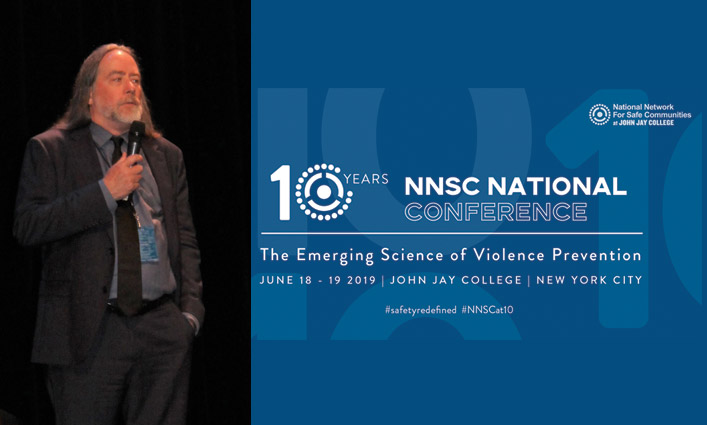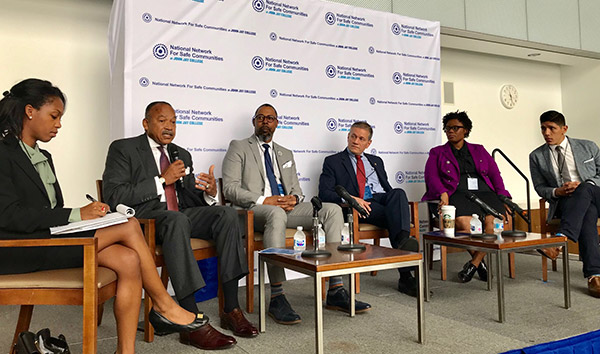
The National Network for Safe Communities (NNSC), which celebrates its 10- year anniversary this year, held its biennial conference on June 18 and 19, bringing together some of the leading minds in crime prevention. Speakers and panelists explored how far the science of violence prevention—finding effective ways to respond to violence that don’t include police or criminal justice intervention, such as empowering communities with resources—has come in the last decade, and discussed how much work still needs to be done. The NNSC has developed a definitive body of research that has helped drive the development of violence prevention research. “The National Network has developed what is now a small but powerful portfolio of proven effective violence prevention approaches,” said Mason as she welcomed the audience to the event. “When I was at the Office of Justice Programs, it was always the work of the National Network for Safe Communities that we turned to as the model for how to develop programs in communities that we knew were disproportionately impacted by violence. We were always grateful for David Kennedy’s advice and wisdom on these issues.”
“You can’t affect violence without being in a relationship with, and supporting and affecting the behavior of those high-risk individuals.” —David Kennedy
Building a Body of Work
During his keynote address, David Kennedy, Director of the NNSC, reflected on the incredible progress made in the science and practice of violence prevention. “I began my field work in 1985, as crack had fully taken hold in Southern California. It was sweeping east and people were dying at unconscionable rates. At the time, the official position of the Los Angeles Police Department was that it could not do anything about people killing each other. In the perspective of the time that made perfect sense,” said Kennedy. “You can’t patrol against homicide because it happens too quickly. By the time you call 911, it’s over and too late. So, the LAPD said, ‘We can do things about robbery, we can do things about burglary and car theft, but there’s nothing we can do about homicide or violence, and we’re not going to hold ourselves accountable for it.’ That’s not true anymore. This is work we now know how to do and can do.”
“Everything that works in violence prevention works to build relationships. It figures out how to communicate. Its figures out how to sustain contact with those high-risk individuals because they need a lot of attention.” —David Kennedy
An important part of that violence prevention work includes reaching out to communities affected by violence, more specifically the small numbers of high-risk individuals. “Everything that works in violence prevention works to build relationships. It figures out how to communicate. Its figures out how to sustain contact with those high-risk individuals because they need a lot of attention,” said Kennedy. “You can’t affect violence without being in a relationship with, and supporting and affecting the behavior of those high-risk individuals.”
Reaching Out to Communities
Further elaborating on how building relationships with communities is essential to creating safer environments were the members of the opening panel session, moderated by Jeremy Travis, Executive Vice President of Criminal Justice, Arnold Ventures, and former President of John Jay College. “What’s at the intersection of our traditional, somewhat siloed ways of thinking about violence prevention?” asked Travis. “The police do this, the communities do that, the hospitals do this, the schools do that. Each of these people on the panel are exploring the grey zones, the intersection or overlap of this work.”
When Vaughn Crandall, Policy Co-Director at the California Partnership for Safe Communities, spoke he detailed the organization’s goal in California. “We work with small cities, primarily in California, to develop and implement public safety strategies oriented towards achieving a triple bottom line. And that is to reduce violence in a community, this includes shootings and homicides; to reduce recidivism and victimization among the young people in our intervention programs; and to build trust between communities affected by violence and the police,” said Crandall. “Really, we’ve come to believe that the public safety future we want requires work on all three of those levels because we are really after maximum safety with minimal incarceration.”

“Engaging doctors and nurses in the conversation, and hiring violence prevention professionals, interventionists who work with patients at their bedside, and follow the patients out in the communities, is really powerful.” —Fatimah Muhammad
Fatimah Muhammad, Executive Director of the National Network of Hospital-based Violence Intervention Programs (NNHVIP) illustrated how violence prevention practice can extend beyond law enforcement parameters. She explained how hospital staff, specifically those working in emergency rooms and trauma centers, have what she called “golden opportunities” to engage with victims of violence. “We have a role to play in this larger framework in helping people recognize that violence is a public health issue,” said Muhammad. “Engaging doctors and nurses in the conversation, and hiring violence prevention professionals, interventionists who work with patients at their bedside, and follow the patients out in the communities, is really powerful. The work extends out into the community. It’s about holding ourselves accountable from a medical perspective to the overall health of these people. And overtime, ensuring that healing is present, not just the absence of violence.”
“When we empower individuals to create the change that they want to see in their community, and we resource them and equip them to sustain that change, then we have healthy environments and healthy communities.”—Eric Cumberbatch
Empowering Communities and Individuals
Making communities safer will require empowering individuals. Eric L. Cumberbatch, Executive Director in the New York City Mayor’s Office to Prevent Gun Violence, spoke of how the agency is reimagining what justice looks like, civilianizing public safety. “The first thing that we’re doing is turning what has traditionally and historically looked like punishing—that’s over-incarceration and prosecution to resolve community issues—and turning it into how to deal with violence, how to deal with individuals that have been harmed, and how to heal the individuals that are allegedly causing harm,” said Cumberbatch. “When we empower individuals to create the change that they want to see in their community, and we resource them and equip them to sustain that change, then we have healthy environments and healthy communities. And when we have healthy environments and healthy communities, we don’t see violent acts.”

“It’s about involving those who are at the center of the issue that we’re trying to address. Empowering those young people so they become part of the solution.” —DeVone Boggan
An essential element of empowering individuals requires involving them in the crime prevention process. DeVone Boggan, Founder & CEO of Advance Peace, told the audience about how hiring formerly criminal justice involved individuals—something he did as Director of the Office of Neighborhood Safety in Richmond, California—helps create positive change within communities. “It’s about involving those who are at the center of the issue that we’re trying to address. Empowering those young people so they become part of the solution,” said Boggan. “Our ideas of who they are will be the substance of our behavior towards them. If we see them as a problem, we are going to treat them as a problem. If we see them as part of the solution, we are going to treat them as part of the solution.” He continued, “We decided to hire street outreach workers and employ them as city employees. One of the minimum qualifications was that they be formerly incarcerated individuals. We wanted to have them come in and work inside the government to help us solve the problem. We couldn’t do it without them.”

Defining Legitimacy and Acknowledging History
On the second day of the conference, attendees heard from New York Police Department First Deputy Commissioner, Benjamin B. Tucker during the “Moving Forward Together: Legitimacy, Procedural Justice, Reconciliation” panel discussion. The panel zeroed in on ways to change policing practices and repair the damage done to marginalized communities. The first step involved defining legitimacy. Tucker told the audience a story he frequently tells new police officers, about a missed opportunity he witnessed in Brooklyn, New York. He explained that one day, he sat in his car at a red light and saw a little boy walking on the sidewalk in awe of a police officer who was standing at his post, but the officer never acknowledged the child. “When I think of legitimacy, and what police are about, I tell these young cops that cautionary tale. You don’t ever want to be that cop,” said Tucker. “When you are in uniform and are in a community, you are one of the people in that community. You are part of the community. Legitimacy begins with that notion of what you are.” He continued, “Being a police officer is a dual role. It’s not just about law enforcement, it’s about citizens. And the way we keep the City safe is to have citizens and police sharing the responsibility of how we do that.”

“Being a police officer is a dual role. It’s not just about law enforcement, it’s about citizens.” —Benjamin B. Tucker
Once legitimacy was established, the panel moved on to building trust in communities. With that goal in mind, they recognized the essential role acknowledging the violent history between law enforcement and communities—particularly within communities of color—plays in building trust. Anthony Titus, Training Supervisor for the Gary, Indiana Police Department, said that often times, officers enter communities not knowing the history, and so they’re met with a community that is defensive, in fear, and angry. “History stole our profession from us. We talk about community deposits and community withdrawal. Well, historically law enforcement has overdrawn from the community’s bank account,” said Titus. To help build trust, Titus explained law enforcement officials would have to be educated on the history, incorporate that knowledge in training, and engage positively with members of the community. “Trust building is really one step at a time. It’s one foot in front of the other. When you have those good interactions with individuals in the community, that person you interacted with becomes your voice in the community. So when there’s officer involved action, instead of having a rush to judgment, you have those voices in the community saying, ‘Wait a minute, let’s see what the officers have to say.’”

Apologizing and Moving Forward
Building trust will not only help with how law enforcement and communities engage with one another, it may also serve as a steppingstone towards reconciliation, or at least the idea of it. A recent apology issued by NYPD Commissioner James O’Neill to the LGBTQ community regarding the Stonewall riots, served as a prime example of the steps law enforcement can take toward mending the divide with marginalized communities. During the LGBTQ Pride Month Community Safety Briefing at One Police Plaza, Commissioner O’Neill stated that the NYPD of today is very different from the NYPD of 50 years ago. “It would be irresponsible of me as we go through World Pride month not to speak of the events at the Stonewall Inn in 1969,” said O’Neill. “What happened should not have happened. The actions taken by the NYPD were wrong, plain and simple. The actions and the laws were discriminatory and oppressive, and for that, I apologize.”
Tucker provided attendees with some insight on O’Neill’s apology. “It’s about telling the truth and acknowledging that something was wrong,” said Tucker. “People said ‘Wow. This is amazing that the Police Commissioner of New York City made this comment and went public with it.’ It’s not rocket science, it’s not complicated. It was the correct thing to do. He manages the agency in that way. We’re trying to get it right and do it right.”



